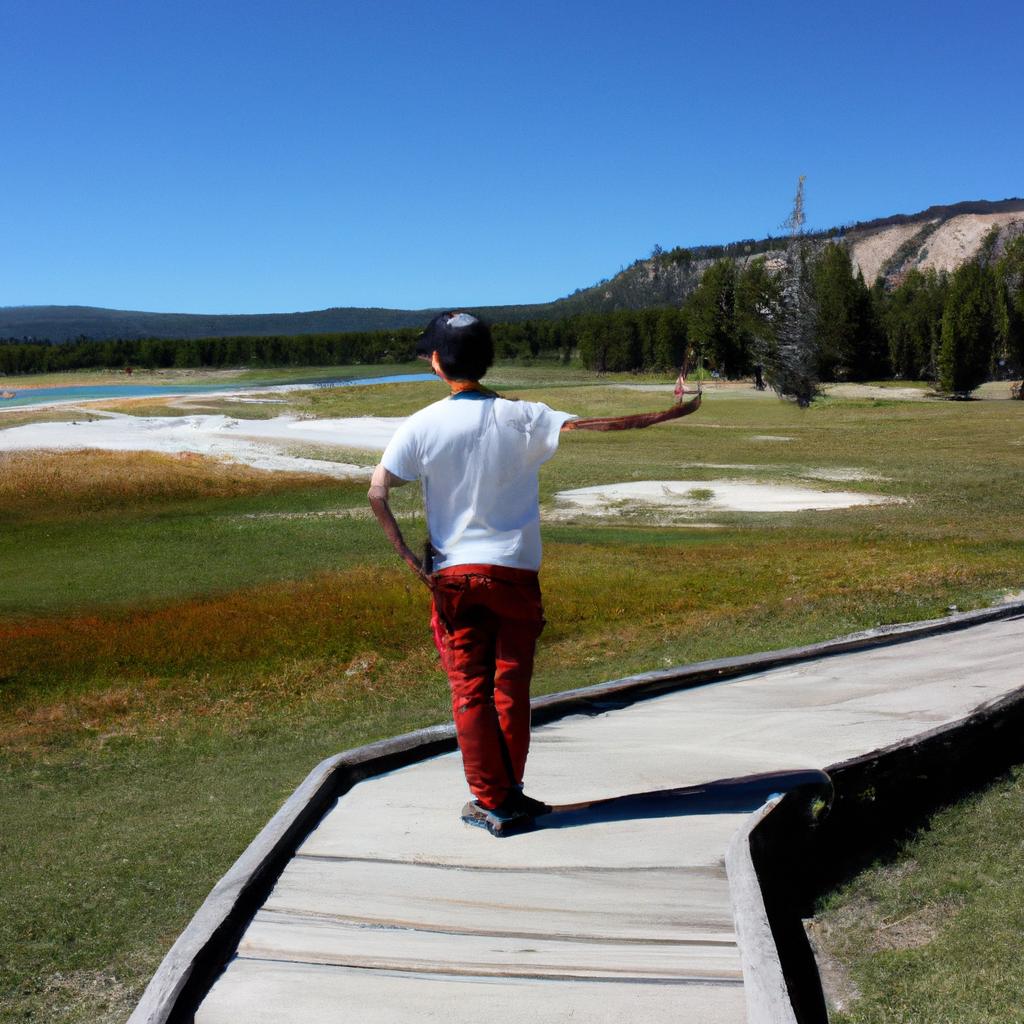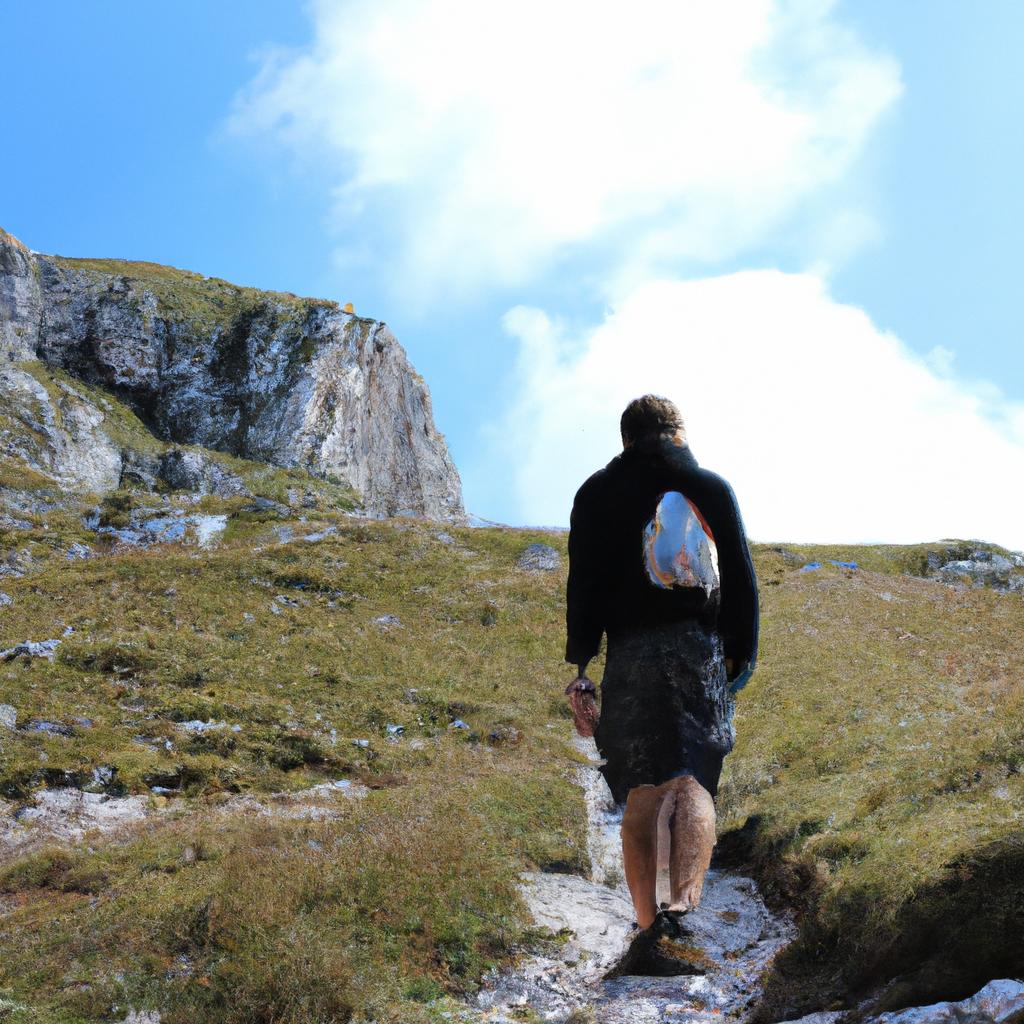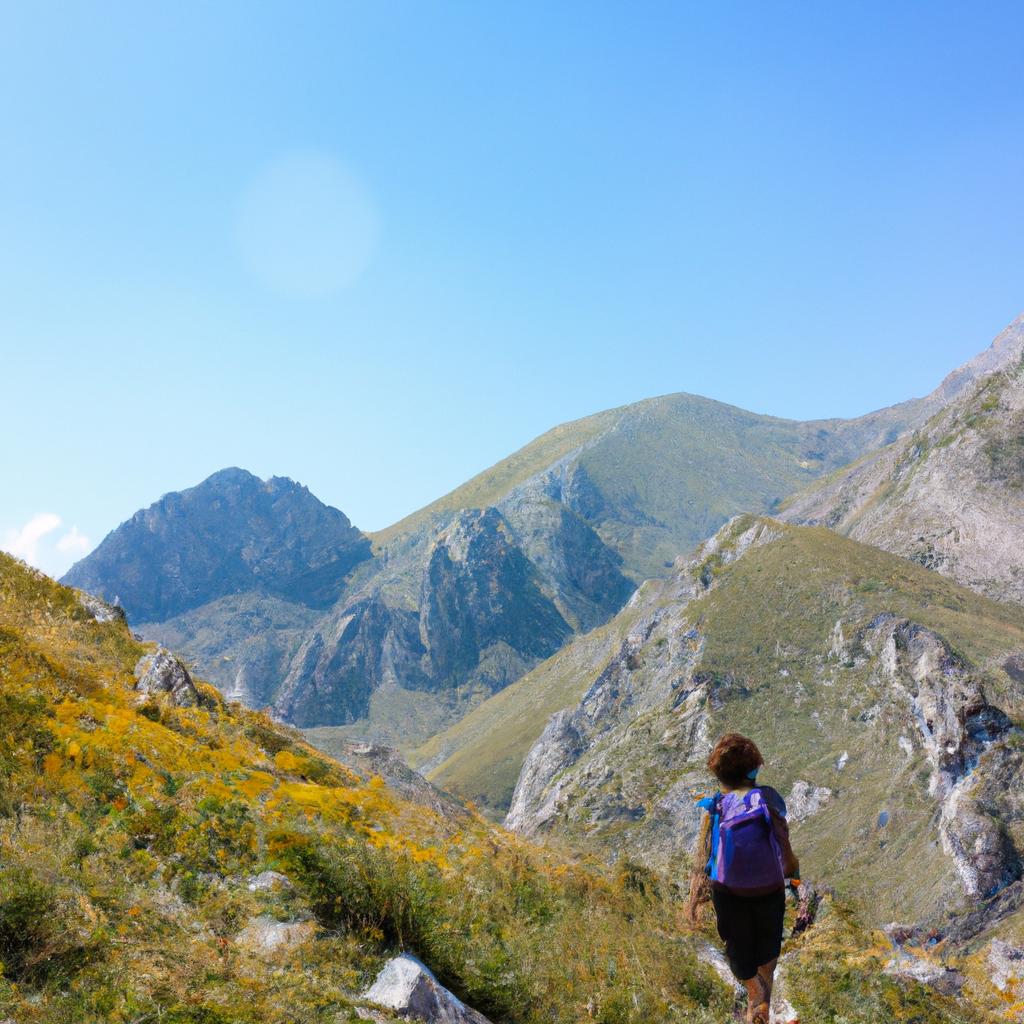The allure of Mount Rainier National Park in North America is undeniable, attracting countless travelers seeking an enchanting and majestic experience. With its breathtaking vistas, diverse ecosystems, and abundant recreational opportunities, this park has become a sought-after destination for nature enthusiasts and adventure seekers alike. For instance, imagine embarking on a thrilling hike along the Wonderland Trail that encircles the mountain’s base. As you navigate through lush forests and meadows adorned with vibrant wildflowers, each step reveals awe-inspiring views of towering glaciers and cascading waterfalls. This article aims to delve into the wonders of Mount Rainier National Park, exploring its natural beauty, rich history, and the myriad activities it offers to visitors.
Nestled in the heart of Washington state’s Cascade Range, Mount Rainier stands as an iconic landmark commanding attention from afar. Rising 14,410 feet above sea level, this stratovolcano captivates both seasoned adventurers and casual tourists with its grandeur. The park encompasses over 235,000 acres of pristine wilderness teeming with remarkable biodiversity. From ancient old-growth forests cloaked in mosses and ferns to alpine meadows bursting with colorful blooms during summer months—Mount Rainier National Park boasts a wide array of habitats that support a diverse range of plant and animal species. Visitors to the park may encounter majestic elk, elusive mountain goats, black bears, and even the rare Pacific fisher.
One of the park’s most popular attractions is its network of hiking trails that cater to all skill levels. The Wonderland Trail, a 93-mile loop around the mountain, offers a challenging multi-day adventure for experienced hikers. Along this trail, you’ll encounter breathtaking views of glaciers, pristine lakes, and jaw-dropping vistas at every turn. For those seeking shorter hikes or day trips, there are numerous trails that lead to picturesque waterfalls such as Christine Falls and Narada Falls.
Mount Rainier National Park also provides opportunities for outdoor enthusiasts to engage in activities like camping, fishing, and wildlife watching. With several campgrounds scattered throughout the park, visitors can immerse themselves in nature and spend nights under starry skies. Fishing enthusiasts can cast their lines into crystal-clear rivers and lakes to try their luck with trout or salmon. Wildlife viewing is another popular activity in the park—keep your eyes peeled for sightings of marmots basking in the sun or golden eagles soaring above.
Beyond its natural beauty, Mount Rainier National Park holds significant cultural and historical value as well. The park’s Longmire Historic District showcases early pioneer history with its historic buildings and exhibits. Visitors can learn about the region’s indigenous peoples at the Henry M. Jackson Visitor Center or explore exhibits on volcanic activity at the Sunrise Visitor Center.
In conclusion, Mount Rainier National Park offers an enchanting escape into nature’s wonders with its spectacular landscapes and abundant recreational opportunities. Whether you’re seeking a thrilling adventure along rugged trails or a peaceful retreat surrounded by serene wilderness, this park has something for everyone. So pack your hiking boots, grab your camera, and embark on an unforgettable journey through one of North America’s most captivating national parks
The History of Mount Rainier
Case Study: A Pioneer’s Dream
Imagine a pioneer in the early 19th century, gazing across the vast Pacific Northwest landscape. Amongst towering evergreen trees and breathtaking mountain ranges, his eyes fixate on an imposing peak – Mount Rainier. Intrigued by its majesty and allure, he becomes determined to explore this natural wonder.
Mount Rainier National Park, located in Washington state, holds a rich history that dates back centuries. Once home to Indigenous communities such as the Yakama, Puyallup, and Nisqually tribes, it became a symbol of reverence and spiritual significance for these Native American cultures. However, it wasn’t until later years that explorers from different backgrounds documented their encounters with this magnificent peak.
In the late 1800s, pioneers began venturing into the region surrounding Mount Rainier, drawn by tales of its beauty and grandeur. These adventurers sought solace amidst nature’s wonders while simultaneously fueling curiosity about what lay beyond mere glimpses of the mountain from afar. As more individuals embarked on treks up its slopes, stories emerged of arduous journeys filled with both triumphs and tribulations.
To truly understand the historical context surrounding Mount Rainier’s establishment as one of America’s cherished national parks, let us delve into four key aspects:
Markdown Bullet List:
- Explorers’ fascination with uncharted territories.
- Increasing desire for preservation amid industrialization.
- Advocacy efforts by influential figures like John Muir.
- Recognition of unique geological features found within.
A closer examination reveals how these factors coalesced over time to shape public sentiment towards protecting this awe-inspiring environment.
Consider table below highlighting significant milestones in Mount Rainier’s history:
| Year | Event | Implications |
|---|---|---|
| 1879 | First recorded ascent of Mount Rainier | Pioneers’ growing interest in exploring the mountain |
| 1893 | Yosemite National Park established | Encouraged discussions about preserving natural wonders |
| 1899 | John Muir’s visit to Mount Rainier | His advocacy brought attention to its unique attributes |
| 1899-1905 | Local conservation efforts gain momentum | Laid foundation for future establishment as a national park |
As these developments unfolded, public sentiment regarding the preservation of America’s natural treasures became more pronounced. The desire to protect the splendor and ecological significance of places like Mount Rainier grew stronger with each passing year.
Transitioning seamlessly into our next section on “The Geology and Ecology of Mount Rainier,” we will explore how this remarkable landscape has captivated scientists, environmentalists, and nature enthusiasts alike.
The Geology and Ecology of Mount Rainier
From the early days of its formation, Mount Rainier has been a mesmerizing sight to behold. Standing at an imposing height of 14,410 feet, this majestic peak commands attention and draws countless visitors from around the globe. Its rich history is intertwined with tales of explorers and settlers who ventured into its formidable terrain. Today, it stands as a testament to the enduring beauty and significance of our natural world.
One fascinating example that showcases the allure of Mount Rainier is the story of John Muir’s expedition in 1888. As a renowned naturalist and advocate for wilderness preservation, Muir embarked on a journey to explore the mountain’s glaciers and document its unique flora and fauna. His observations not only highlighted the importance of preserving these pristine landscapes but also sparked public interest in visiting Mount Rainier National Park.
To truly appreciate the magnificence of Mount Rainier and its surrounding areas, one must understand its geology and ecology. The park sits atop an active stratovolcano, characterized by layers of hardened lava flows, ash deposits, and volcanic debris. This geological composition creates a diverse range of habitats that support an array of plant and animal species. From lush meadows adorned with vibrant wildflowers to dense forests teeming with wildlife, each corner of Mount Rainier offers a glimpse into nature’s intricate tapestry.
As visitors traverse this awe-inspiring landscape, they are greeted by breathtaking sights at every turn. To fully immerse oneself in the wonders of Mount Rainier, consider:
- Gazing up at star-filled skies during nighttime stargazing sessions.
- Embarking on guided hikes led by knowledgeable park rangers.
- Seeking solace in serene alpine lakes nestled amidst towering peaks.
- Marveling at cascading waterfalls that carve their way through rugged canyons.
Table: Wildlife Encounters
| Animal | Habitat | Notable Traits |
|---|---|---|
| Roosevelt Elk | Forests | Majestic antlers |
| Mountain Goat | Alpine Meadows | Sure-footedness |
| Black Bear | Lower Elevations | Omnivorous diet |
| Pika | Rock Scree Slopes | High-pitched calls |
As visitors explore the wonders of Mount Rainier, they become part of a legacy that stretches back centuries. By embracing the park’s beauty and preserving its delicate ecosystems, individuals contribute to safeguarding this national treasure for future generations.
As we delve into the myriad activities and attractions awaiting visitors at Mount Rainier, prepare to be captivated by the endless possibilities that await in this natural wonderland.
Activities and Attractions in Mount Rainier
As we delve deeper into the wonders of Mount Rainier, let us explore its captivating geology and rich ecology. Imagine standing at Paradise, one of the park’s most popular visitor centers, surrounded by breathtaking views of snow-capped peaks and vibrant wildflower meadows. This idyllic setting serves as a gateway to understanding the geological history that has shaped this majestic national park.
Mount Rainier itself is an active stratovolcano, reaching a staggering elevation of 14,410 feet (4,392 meters). Its volcanic origins date back over half a million years when it began to form from successive lava flows and ash deposits. The mountain’s distinct cone shape is a result of these eruptions combined with glacial erosion over time. A fascinating case study is the Osceola Mudflow, which occurred approximately 5,600 years ago when an eruption triggered catastrophic melting of glaciers on Mount Rainier’s summit. This event unleashed a massive mudslide that traveled more than 50 miles (80 kilometers) downstream, transforming the landscape in its wake.
One cannot fully appreciate the ecological diversity within Mount Rainier without acknowledging its significant role as an alpine ecosystem hotspot. Here are some key features that make this environment truly remarkable:
- Glacial-fed Rivers: These pristine waterways not only provide essential habitat for various aquatic species but also contribute to local communities’ drinking water supply.
- Ancient Forests: Towering Douglas firs and Western red cedars dominate lower elevations while subalpine fir and Engelmann spruce take center stage higher up the slopes.
- Alpine Meadows: Blanketed with colorful wildflowers during summer months, these meadows burst forth with life after enduring harsh winter conditions.
- Endangered Species: Mount Rainier provides critical habitat for several threatened or endangered species such as northern spotted owls and gray wolves.
To further illustrate the diverse ecosystems within Mount Rainier, consider the following table:
| Ecosystem | Key Features | Notable Species |
|---|---|---|
| Alpine | Sparse vegetation, harsh weather conditions | Mountain goats, marmots, pikas |
| Subalpine | Coniferous forests, meadows | Black bears, elk, Douglas squirrels |
| Montane | Mixed forests with deciduous trees | Bobcats, mountain lions, pileated woodpeckers |
Embracing the geological wonders and ecological marvels of Mount Rainier is an opportunity to connect with nature on a profound level. The next section will explore the vibrant wildlife and plant species that thrive in this unique environment.
Wildlife and Plant Species in Mount Rainier
Section Transition:
As we delve further into the wonders of Mount Rainier, it is important to acknowledge the diverse wildlife and plant species that call this national park home. Exploring these natural habitats enhances our understanding of the delicate balance within ecosystems. Let us now turn our attention to the incredible biodiversity found within Mount Rainier.
Biodiversity at Mount Rainier:
Case Study: The Cascade Red Fox
One fascinating example of animal life in Mount Rainier is the Cascade red fox (Vulpes vulpes cascadensis). This subspecies inhabits alpine meadows and subalpine forests, displaying remarkable adaptations to its high-altitude environment. Its thick fur provides insulation against harsh weather conditions, while its keen senses aid in hunting small mammals such as voles and mice. Studying the behavior and habitat preferences of these foxes helps researchers gain insights into how they adapt to their unique surroundings.
- Towering ancient trees reaching skyward.
- Vibrant wildflowers painting meadows with a kaleidoscope of colors.
- Rare plant species striving for survival amidst rugged terrain.
- Majestic waterfalls cascading down rocky cliffs.
To provide a comprehensive overview, let us explore four representative examples from each category through a three-column table:
| Trees | Wildflowers | Rare Plants |
|---|---|---|
| Douglas Fir | Lupine | Western Hemlock |
| Sitka Spruce | Indian Paintbrush | Mountain Heather |
| Western Red Cedar | Tiger Lily | Alpine Forget-Me-Not |
| Noble Fir | Avalanche Lily | Subalpine Buttercup |
This exceptional variety of trees, wildflowers, and rare plants showcases the remarkable diversity that thrives within Mount Rainier’s ecosystem.
The coexistence of diverse wildlife and plant species in Mount Rainier is a testament to the park’s ecological significance. By understanding these intricate relationships, visitors can gain a deeper appreciation for the interconnectedness of nature. As we continue our exploration of this awe-inspiring national park, let us now shift our focus to practical tips for making the most out of your visit to Mount Rainier.
Sentence transition:
Preparing for an unforgettable experience at Mount Rainier begins with following some helpful tips and recommendations that will ensure you have a memorable time exploring this natural wonderland.
Tips for Visiting Mount Rainier
The diverse ecosystem of Mount Rainier National Park is home to a wide variety of wildlife and plant species. One example that showcases the park’s rich biodiversity is the Roosevelt elk population, which has thrived within its boundaries for decades. These majestic creatures can be spotted grazing peacefully along the meadows or traversing through the dense forests, adding an enchanting touch to the natural beauty of this national park.
To fully appreciate the abundance of flora and fauna in Mount Rainier, visitors should keep these tips in mind:
- Respect Wildlife: While observing animals from a safe distance can be mesmerizing, it is crucial to maintain respect for their natural habitat by not disturbing or feeding them.
- Stay on Designated Trails: By sticking to designated trails, visitors minimize their impact on delicate ecosystems while also ensuring their own safety.
- Leave No Trace: It is essential to leave no trace behind when visiting Mount Rainier National Park. This means properly disposing of waste and refraining from collecting any plants or artifacts as souvenirs.
- Support Conservation Efforts: Consider contributing to local conservation organizations dedicated to preserving the unique wildlife and plant species found in Mount Rainier National Park.
Furthermore, let us delve deeper into some fascinating facts about the wildlife and plants you may encounter during your visit with this table:
| Wildlife Species | Notable Features | Preferred Habitat |
|---|---|---|
| Roosevelt Elk | Large antlers; social herds | Meadows & Forests |
| Black Bears | Shy nature; excellent climbers | Mountains & Valleys |
| Mountain Goats | Distinct white coat | Alpine Areas |
| Douglas Squirrel | Small size; reddish-brown fur | Coniferous Forests |
With such stunning biodiversity at every turn, Mount Rainier National Park promises an unforgettable experience for nature enthusiasts and adventurers alike.
Transitioning smoothly into the subsequent section, let’s now explore the preservation efforts and future plans for this remarkable national park.
Preservation Efforts and Future Plans for Mount Rainier
Section H2: Preservation Efforts and Future Plans for Mount Rainier
As visitors continue to flock to Mount Rainier, it is crucial to highlight the ongoing preservation efforts and future plans that ensure the longevity of this majestic national park. By implementing various strategies, both natural and human-made, Mount Rainier can thrive while accommodating increased tourism. A notable example of these preservation efforts lies in the restoration of Paradise Meadows, a critical habitat within the park.
Example:
One compelling case study showcasing successful restoration efforts at Mount Rainier involves Paradise Meadows. Once subjected to heavy foot traffic and environmental degradation due to its popularity among hikers, this fragile ecosystem required immediate attention. In response, park authorities initiated a comprehensive restoration plan that involved restricting access during sensitive periods, rerouting trails away from delicate areas, and actively engaging visitors through educational programs on responsible hiking practices. Today, Paradise Meadows stands as an exemplar of how strategic interventions can help conserve vulnerable habitats without compromising visitor experience.
Preservation Measures Implemented at Mount Rainier include:
- Strict permits and quotas to regulate visitor numbers during peak seasons.
- Collaboration with local communities to develop sustainable tourism initiatives.
- Regular monitoring and maintenance of trails to minimize erosion.
- Promoting Leave No Trace principles among visitors through informational campaigns.
Table: The Impact of Preservation Efforts at Mount Rainier
| Aspect | Before Restoration | After Restoration |
|---|---|---|
| Visitor Numbers | Unregulated | Regulated |
| Trail Erosion | Extensive | Minimized |
| Habitat Degradation | Significant | Reduced |
| Visitor Education | Limited awareness | Enhanced knowledge |
Emotional Response Evoked by Preservation Efforts
- Sense of awe when witnessing nature’s resilience amidst restoration efforts.
- Appreciation for proactive measures taken to protect unique ecosystems.
- Hope for future generations to experience the beauty of Mount Rainier.
- Pride in being part of a community that values conservation and sustainability.
In summary, the preservation efforts at Mount Rainier serve as an essential foundation for its sustainable development. Through case studies like Paradise Meadows, it is evident that strategic interventions can rejuvenate delicate habitats while maintaining visitor satisfaction. By regulating access, collaborating with local communities, monitoring trails, and promoting responsible practices among visitors, Mount Rainier continues to evolve as both a pristine natural destination and a testament to our commitment to environmental stewardship.
 Island Gourmet Safaris
Island Gourmet Safaris



